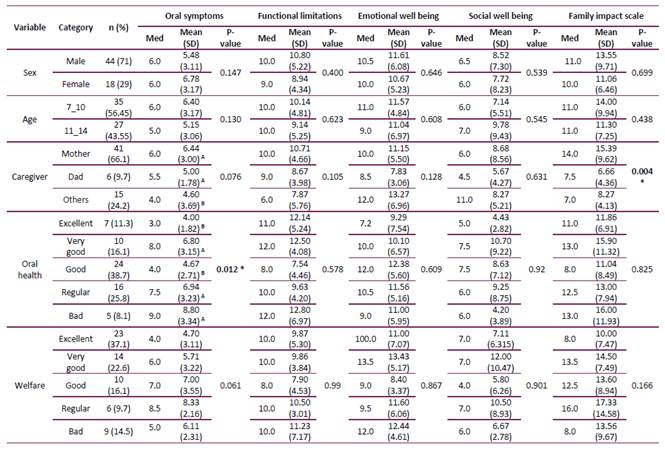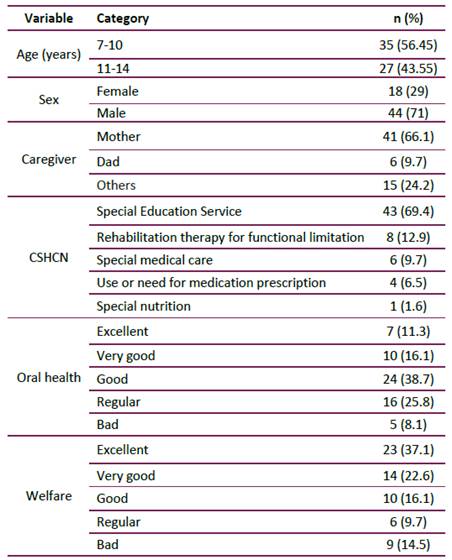Introduction
Individuals with special health care needs (SHCN) are individuals who present modifications that require special approaches in all fields of health for a period of their life or indefinitely 1. Currently, according to the World Health Organization (WHO), about one billion people live with some form of disability, which corresponds to one in seven people in the world 2. It was estimated that approximately 24% of the Brazilian population had some intellectual, motor, hearing and/or visual disability 3.
The WHO (1995) defined the concept of quality of life as the self-perception that the individual has about his position in the social, cultural and ideological context, being these factors the main responsible for denoting the worst parameters regarding oral health care during the dental clinical examination performed by the dentist 4. In recent years, the literature has turned its attention to the influence of comorbidities on the quality of life of SNCN patients 5-8. Diseases such as caries, periodontal disease and malocclusions, often present in this population, are related to a worsening in quality of life 8-11.
Faced with the limitations imposed by deficiency, caregivers are the main protagonists in decision-making regarding the dental treatment plan and the state of health of these children 12-14. The literature shows some instruments of measures to evaluate the quality of life from the children's perspective and also from the caregivers' perspective, considering the psychological, social and economic indicators for oral health 15-17. The development of these instruments present a positive and growing perspective in dental research since clinical criteria do not allow determining the real impact of oral health needs 18,19. Thus, the data obtained by these questionnaires allow the adoption of public policies in oral health for both individual and collective treatment, in addition to optimizing time for decision making regarding clinical, social and oral health promotion interventions 19,20. Moreover, there are no reports that the most varied types of syndromes lead to differences in parents' perception regarding changes in quality of life.
Therefore, the objectives of this study were: 1) to evaluate the impact of oral health on the quality of life of children with SHCN between 7 and 14 years and 2) the influence of different types of specialties on the quality of life, in the view of caregivers in a mid-sized municipality in the Brazil southeast region.
Materials and methods
The guidelines STROBE Statement (Strengthening the Reporting of Observational studies in Epidemiology) was followed for this study 21.
Ethical Approval
The study followed the norms determined by the Brazilian resolution 466 (2012) for research with Human Beings. The study was protocolled and approved by the Committee on Ethics in Research Involving Human Beings of Federal University of Alfenas (UNIFAL), under the report number (2.717.792/2018). The study was attended by parents and caregivers who agreed with the terms of the research and signed the Informed Consent Term.
Study Location
This study was developed in Alfenas-MG, Brazil. This municipality is located in the South of state of Minas Gerais, with a total area of 850,446 km², having a population of 79,996 inhabitants and a demographic density of 84.75 (inhabitants/km²) having predominantly the population in the urban perimeter 22. In Alfenas, a national institution, the Association of Parents and Friends of the Exceptional (APAE), acts in attention psychosocial, educational and health care of the SHCN patients, and the municipal schools that also include these patients 23.
Study Sample
For this descriptive and cross-sectional study, a convenience sample was obtained from a list of all children with SHCN enrolled in public schools or attending APAE-Alfenas, Brazil. All children between 7 and 14 years of age were included; with any kind of special need and willing to receive the researcher in home environment.
The initial sample was 132 children. The children's parents were first approached by telephone and informed about the study in order to be invited to participate in the survey. Afterwards, home visits were made to apply the instrument. 56 could not be contacted or changed addresses and 15 did not want to participate in the study. Thus, the final sample of the study was 62 children and their respective caregivers.
Characterization of the speciality of children
The children and adolescents in the sample were allocated to groups according to the criteria determined by the Chilean Society of Pediatrics, which characterizes SHCN according to their medical, dental, nutritional and educational needs 24.
Calibration of Researchers
The evaluators were two graduates in Dentistry from UNIFAL (FIDC and LBO), previously trained and calibrated. For calibration, the questionnaire was in different periods with the same caregiver to verify the understanding of the questions contained in the instrument. At the end, a Kappa= 0.91 was obtained.
P-CPQ instrument
The instrument used in the study was the brazilian version of the Parental Caregiver Perceptions- questionnaire (P-CPQ) composed of 33 questions distributed in four domains: oral symptoms, functional limitations, emotional well-being and social well-being, taking into account that the events assessed should have occurred frequently in the last three months. For each answer, the Likert Scale was used: (never = 0, once or twice = 1, sometimes = 2, often = 3, every day or almost every day = 4). The answer "Don't know" was also inserted in order not to lose valuable data regarding the oral health status of the studied group, being scored as 5 points. After the application of the instrument, the sum of each domain was performed, with a higher score denoting a greater impact on the quality of life conditions in oral health of children with special needs 15.
Results
Of the 132 caregivers consulted, 62 were interviewed, leading to a response rate of 46.96%. The characterization of the population is described in Table 1. The sample consisted of 44 male (71%) and 18 female (29%) individuals. The mother was the main transmitter of the data (n=41- 66.1%) when evaluating who was the caregiver or responsible for the child transmitting the information. Patients with service needs and special education (Autism, HASD, intellectual disability and hyperactivity syndrome) was the type of special need more prevalent in this study (n=43- 69.4%).
Table 2 shows the results of the analysis of the P-CPQ questionnaire domains. The scores "Emotional Well-Being" and "Family Impact Scale" were higher than the other domains. When the P-CPQ base factors were evaluated 13 individuals (20.96%) obtained the lowest scores (0 points) and no individual obtained the highest score (125 points).
Table 2 P-CPQ according to total scale and domains. Alfenas, MG, Brazil, 2020.

¹ Proportion with 0 score.
² Proportion with maximum score
In the bivariate analysis, the worst states in relation to quality of life were obtained when the mother and father were the transmitters of the information (p=0.004). The variable Oral health of the child (p = 0.012) were related to the worst parameters of perception on quality of life from the perspective of symptoms or oral disorders that the special children had (Table 3).
In Table 4, there was no association between the type of special need of the child and the values obtained in P-CPQ.
Table 3 Bivariate analysis of association between demographic status with oral health-related quality of life in the domains median scores of P-CPQ Alfenas, MG, Brazil, 2020.

Med= Median; *Different overwritten bold letters indicate the statistic significant differences in comparison between groups (Dunn’s Post-test; p<0,05)
Discussion
Patients with SHCN have several comorbidities that may negatively influence their quality of life 18,20. Poor oral health conditions are not rare in this segment of the population due to the difficulties and limitations in achieving adequate standards of oral hygiene and diet control 13,14. Therefore, this cross-sectional study had as main axis to evaluate the impact of oral health conditions of patients with SHCN on quality of life, from the caregivers' point of view.
In this context, the main caregiver of the child with SHCN is the one who can provide the best insight into the perception of oral health status and how much it influences the life of the child/adolescent in a positive or negative way 25,26. This statement is directly related to the importance he attaches to good oral health conditions 27,28. The literature shows that good oral hygiene practices were correlated with the caregiver and/or the child's primary caregiver 29. For Silva et al., 2018 the caregiver factor, in 81.5% of cases, is the main responsible for the initial awareness of primary oral health care of their children with SHCN 30.
Our results show that the worst parameters in relation to quality of life were observed when the mother and father were responsible for transmitting the data. This can be endorsed by the findings of Locker et al., 2007; Piovesan et al., 2010; Paula et al.,2012 and dePaula et al., 2013 that show that parents showed a more acute self-perception in relation to oral health care, this factor being influenced by the demographic and socioeconomic aspects in which they live 19,31-33.
From this perspective, the quality of life questionnaires have shown positive results regarding the measurement of oral health impacts 17,34,35. When analyzed the scores, studies involving children with SHCN showed a greater tendency to obtain higher scores for oral symptoms, emotional well-being and functional limitations. The justification for the higher score is that oral diseases directly and negatively interfere with child welfare 7,36,37.
The mean values of the P-CPQ domains Oral Health Status was statistically significant in negatively influencing quality of life. In this sense, it is important to highlight that children with SHCN present high rates of caries, periodontal disease and malocclusions, which, identified by caregivers, justify their self-perception and association between a poor oral health status and a drop in quality of life 19,20,32. Hence the importance of this study in demonstrating the importance of the caregiver's role, especially for parants as our results show in the perception of the oral health status of their children with SHCN 32,33.
Still regarding oral health status, evidence reinforces these findings, as demonstrated by Abanto et al., 2012 that associated poor oral health conditions to clinical examination with poor quality of life results in the application of P-CPQ in patients with cerebral palsy 7. Similarly, Baens-Ferrer et al., 2004 showed that oral diseases significantly compromise the exercise of daily functions in children with SHCN, before and after oral rehabilitation under general anesthesia and Alves et al., 2016 in children with intellectual disabilities 5,20.
Our results showed that the largest number of SHCN that composed the sample belonged to the group of patients with service needs and special education and that there was no association between the type of special need of SHCN and the values obtained in P-CPQ. It was not possible to associate these data with those in the literature, since to our understanding there are no studies evaluating the relationship between the type of specialty of the individual and its impact on quality of life.
Finally, the number of patients interviewed is a partial limitation of this study. The constant change of telephone and address of the participants was the main responsible for the reduction of the sample. We talked about partial limitation, since, even with the reduction, statistically significant results were obtained.
From this study it is possible to infer that the caregiver is the key factor to add better oral health conditions for the children as they are responsible for the changes regarding preventive behavior and good oral health practices of their special children.

















